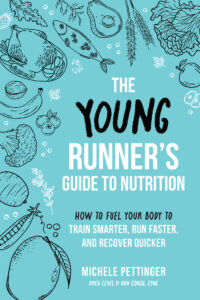The following excerpt about the need for protein, carbs and fats for young runners is from The Young Runner’s Guide to Nutrition by Michele Pettinger.
Follow FLEETSTREET on Instagram and TikTok.
Optimizing nutrition for performance and recovery
Nutrition is also a valuable component that can help athletes both protect themselves and improve performance.
—Bill Toomey
In chapter 1, we explored the changes that occur in your body during adolescence. We discussed how nutrition is a powerful tool in controlling your hormones, which in turn aff ect bone health, muscle development, and brain and cognitive function. In this chapter, we will take a deeper look into the macronutrients, micronutrients, and hydration protocols that create an optimal nutrition environment that sets you up for improving performance and recovery.
Just as you would carefully select the best materials and tools to construct a custom home that can withstand environmental pressures, in this chapter, we will help you set up yourbody to grow, develop, and endure the demands of running, school, and other life activities. These essential tools are the nutrients you use to fuel: macronutrients, micronutrients, and hydration. But before we take a closer look, let’s first understand two key concepts: metabolism and energy availability.
Have you ever been running along and reached a point in the run where your legs start to feel heavy, your breathing is laboured, and you feel like you’re running through quicksand? You may have heard the term hitting the wall; that is what it feels like—when your energy reserves are so depleted that you can’t imagine running another step.
Think of your metabolism as the engine that keeps your body running. Just like your home’s furnace, it needs fuel to operate. If it’s not getting enough power, it won’t be able to keep up with your physical activity, leading to that feeling of hitting the wall.
Your metabolic rate—the speed at which your body burns fuel—varies from person to person. It is influenced by age, gender, body composition (the ratio of fat, muscle, and bone), activity level, and genetics. Hormonal changes or shifts in body composition can also impact how efficiently your metabolism performs.
Repeated instances of feeling like you’ve hit the wall can lead to low energy availability (LEA). This condition can affect metabolism, cause hormonal imbalance and fatigue, and impair immune function, thereby increasing the risk of injury and illness.
Need motivation? Katie Sin will cheer you on.
Macronutrients for young runners
Macronutrients are the nutrients consumed in significant amounts throughout the day to keep your body functioning normally. Just as the material, size, and placement of the building blocks you chose for your house impact its structural integrity, framing, and protection, macronutrients are the building blocks of your body. The quality, amounts, and timing of when you consume them all affect the functions they support, such as providing the energy you need for daily activities, running, and mental tasks; helping build muscle; repairing damaged tissue; regulating your body temperature; and protecting your organs. Macronutrients, which include carbohydrates, proteins, and fats, are the key to your body’s performance.
Resolved to run? Think wisely about body image.
Carbohydrates for young runners
Carbohydrates, often referred to as the fuel for your body, are the primary source of energy. Think of them as the power that drives the construction equipment needed to build your house.
When you consume carbohydrate-rich foods like grains and vegetables, your body breaks them down into glucose, a form of sugar that fuels the cells powering your muscles. This energy is what keeps you going during your workouts and daily activities.
Studies have shown that adolescents store less glycogen than adults; therefore, carbohydrates should make up the majority of the increased caloric needs of the adolescent athlete. Regardless of age, low carbohydrate intake in athletes can cause poor energy levels if glycogen stores become too depleted, causing you to feel sluggish in your workouts and to have difficulty concentrating in the classroom.
All carbohydrates are not created equal. There are complex carbohydrates and simple carbohydrates.
Orangetheory Strength 50 Review: Can you peel the burn?
Complex carbohydrates
Complex carbohydrates, the essential building blocks for your body’s energy needs, are made of long chains of sugar molecules that take longer for your body to break down and digest.
This slow digestion is a good thing! It allows for a gradual release of glucose into your bloodstream, providing a steady energy source over an extended period. The sustained release of energy from complex carbohydrates ensures that you have a consistent and constant supply of power, which helps delay the onset of fatigue and stabilize blood sugar, preventing the feeling of energy highs and crashes.
Complex carbohydrates also contain dietary fibre, which is essential for your intake as it promotes a healthy digestive system for regular bowel movements. High-fibre foods like fruits and vegetables also contain water, which can improve your overall hydration. Fibre also acts as a prebiotic, feeding beneficial bacteria into your gut. A healthy gut microbiome is associated with better digestion, nutrient absorption, and immune function.
What is a gut microbiome?
The community of bacteria in your stomach helps keep your immune system strong, aids in digestion, and even affects your mood and energy levels. You can support a healthy gut microbiome by eating a lot of fruits, vegetables, whole grains, and prebiotic foods like yogurt and kefir. Note: As a runner, you need to be aware of the timing of consuming dietary fibre.
Simple carbohydrates
Whereas complex carbohydrates are made of long chains of sugar molecules, simple carbohydrates are made of just a few sugar molecules. Unlike the building blocks of complex carbohydrates, they are easy to break down and digest, making them immediately available for your muscles to access and ideal for snacks before, during, and after workouts. You will learn more about this in chapter 3. Because they spike your blood sugar, they should be used in moderation, as too much at the wrong time can leave you feeling fatigued.
To better understand how much carbohydrate you may need to fuel your body and properly enhance your running and training, the Youth Running Consensus Statement recommends six to 10 grams carbohydrate per kilogram of bodyweight per day. You might be more familiar with thinking of food intake in terms of calories, so the equivalent in calories is also shown on the next page. See table A.1 (page 248) for how to convert pounds to kilograms, and see table A.2 (page 249) for how to convert grams of carbohydrate to calories.
Destination run? Increasing intensity? Thinking about exercising in the heat? You should read this.
Complex carbs versus simple carbs
Average carbohydrate intake for a young female runner who weighs 56 kilograms (about 125 pounds):
336 to 560grams per day or 1,344 to 2,240 calories per day
Average carbohydrate intake for a young male runner who weighs 61 kilograms (about 135 pounds):
366 to 610grams per day or 1,464 to 2,440 calories per day
To apply these calculations to yourself and determine your specific needs, see “How to Create Your Personal Nutrition Profile” on page 251.
Peloton Tread review: Is it worth the money?
Protein for young runners
While carbohydrates are the primary fuel source for your body’s energy supply, protein plays a crucial role in maintaining a sound structure. Proteins are the architects of muscle building and the engineers of tissue repair, ensuring your body is always ready for daily activities and running.
Amino acids, the building blocks of proteins, are small molecules that bind together to form these vital nutrients. There are nine essential amino acids and 11 non-essential amino acids. However, our bodies cannot produce essential amino acids, so we must obtain them from food.
Protein sources
| Animal Protein Sources | Plant-Based Protein Sources |
|---|---|
| Meat: beef, poultry, pork and more | Quinoa |
| Fish: salmon, tuna, cod and more | Buckwheat |
| Eggs | Soy: beans, tofu, tempeh, edamame and more |
| Dairy: milk, cheese, yogurt and more | Chia seeds (which also provide omega-3 fatty acids) |
| Hemp seeds (a powerhouse that are a source of all essential amino acids, healthy fats and fibre) | |
| Spirulina (a high-protein and nutrient-dense blue green algae; a great option for adding to smoothies, see page 204) |
To better understand how much protein you need to help your body repair and rebuild, the Youth Running Consensus Statement recommends 1.2 to 2 grams of kilograms in bodyweight per day. As with the carbohydrates, see table A.2 on page 249 for how to convert grams of protein to calories.
Average protein intake for the young female runner who weighs 56 kilograms (about 125 pounds):
67 to 112 grams per day or 268 to 448 calories per day
Average protein intake for a young male runner who weighs 61 kilograms (about 135 pounds):
73 to 122g or 292 to 488 calories per day
You can also use these guidelines to determine your specific needs. See “How to Create Your Personal Nutrition Profile” on page 251.
Protein should primarily come from whole food sources, spaced in 20- to 30-gram servings throughout the day. To prevent muscle breakdown, focus on consuming lean protein with each meal and snack throughout the day, most specifically 20 grams of protein following a workout. You can read more about protein timing in chapter 3.
Protein meal planning that’s not boring.
What 20 grams of protein looks like
| 3 eggs |
| 3 to 4 ounces chicken, pork, beef or fish |
| 8 to 9 ounces tofu |
| 20 ounces milk |
| 1 cup Greek yogurt |
| ¾ cup cottage cheese |
| ½ cup legumes |
The viral high-protein bagels from TikTok you’ll want to make on repeat.
Fat for young runners
Carbohydrates are the primary fuel of our body’s energy supply. Proteins offer structural integrity by coming in to repair and rebuild damaged muscle tissue. Fats are an added layer of protection and support, like insulation and reinforcement beams. Fats insulate the body, regulating temperature and protecting organs. They are needed to absorb fat-soluble vitamins (A, D, E, and K) and to produce cholesterol and sex hormones.

Fats are a dense energy source providing more than twice the calories per gram compared to carbohydrates and protein.
During high-intensity exercise, simple carbohydrates are used first for quick energy but are quickly depleted. As exercise lasts longer or intensity decreases, the body gradually shifts to using fats, which are metabolized more slowly and provide sustained energy.
The science shows that adolescents can more easily use fat stores as a fuel source than adults. Fat should constitute 20 to 35 per cent of your daily intake, with the majority coming from heart-healthy unsaturated fats.
To better understand the amount of healthy fats you need to consume for energy, absorbing vitamins, and hormone production, the Youth Running Consensus Statement recommends 1 to 2 grams per kilogram of body weight per day. (As with the carbohydrates and protein, see table A.2 in the Appendix for how to convert grams of fat to calories.)
Average fat intake for a young female runner who weighs 56 kilograms (about 125 pounds):
56 to 112 grams per day or 504 to 1,008 calories per day
Average fat intake for a young male runner who weighs 61 kilograms (about 135 pounds):
61 to 122 grams per day or 549 to 1,098 calories per day
Remember, you can apply these, and other, calculations to yourself and determine your specific needs by following the steps in “Creating Your Personal Nutrition Profile,” in the Appendix.
What are macros? Should you care?
Examples of healthy fat
| Fish |
| Avocado |
| Nuts, seeds and olive oil |
| Eggs |
| Beans |
| Omega-3 fortified breads and cereals |

Excerpted from The Young Runner’s Guide to Nutrition by Michele Pettinger. Copyright © 2025 VeloPress. Reprinted with permission from VeloPress. New York, NY. All rights reserved.

